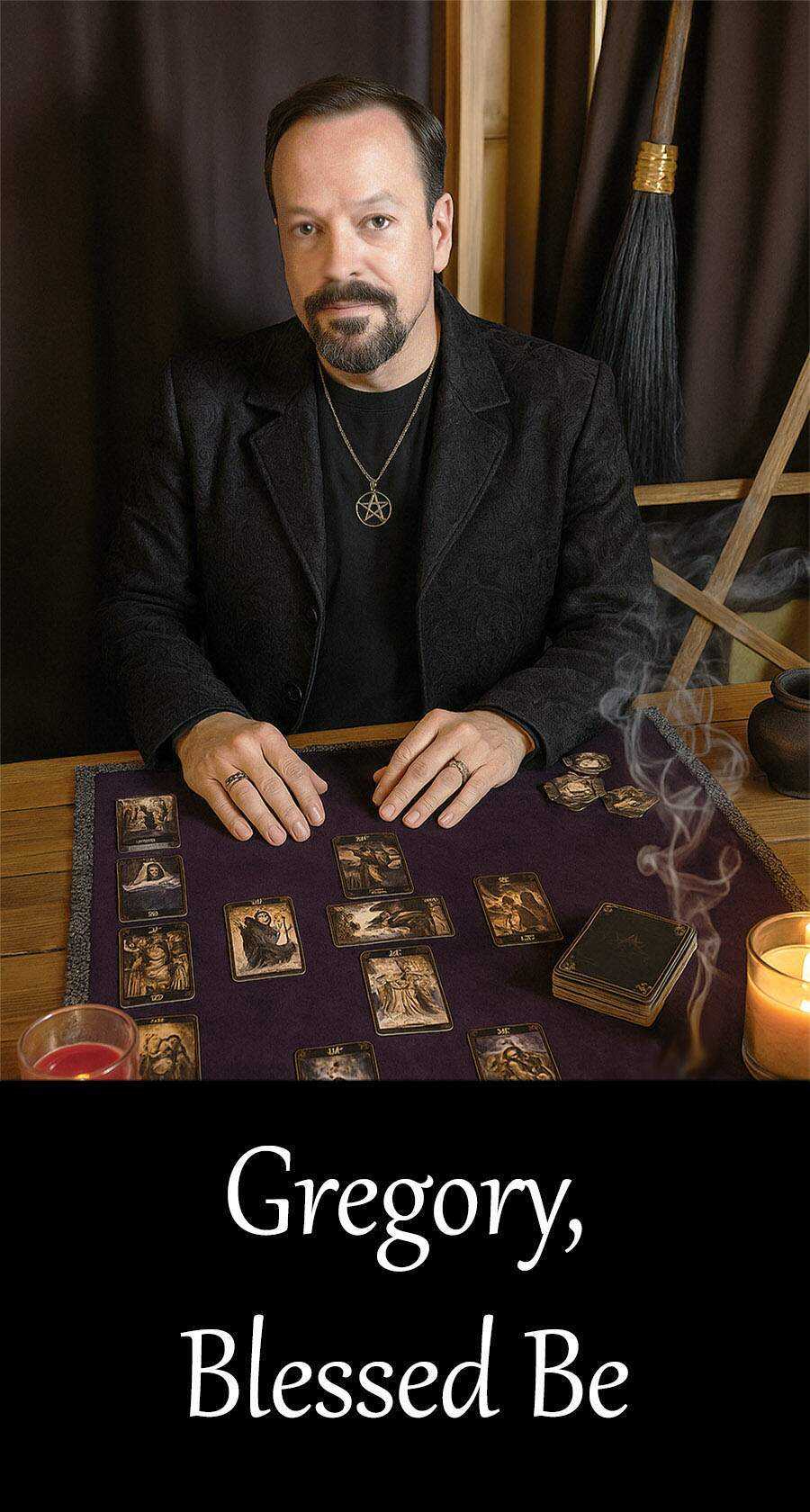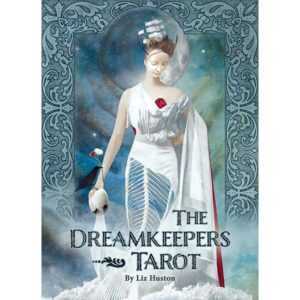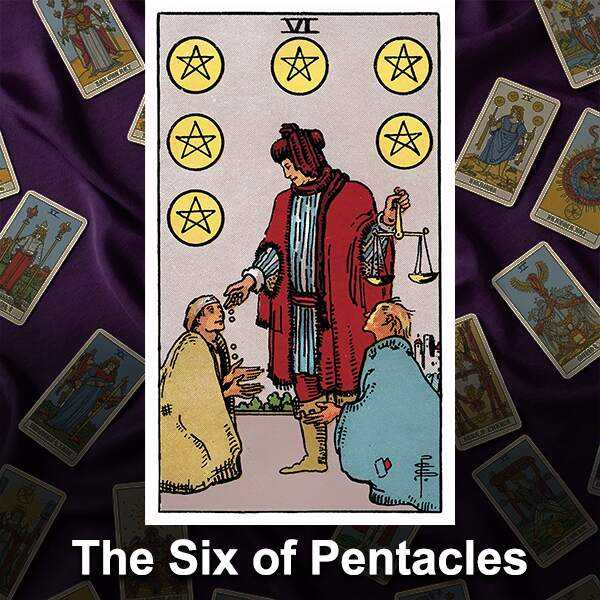The Six of Pentacles is a card that speaks to the flow of giving and receiving. Moreover, it often points toward generosity, balance in resources, and lessons about charity and fairness. At its core, this card reminds us that power shifts over time. Consequently, sometimes we are in the role of giver, while at other times we are the one in need.
 I use my P.E.N.S.I. method when I teach Tarot. That stands for Position, Element, Numerology, Symbolism, and Intuition. Each layer helps us understand a card more deeply. Because we are working through single cards here, Position is only touched on lightly as context.
I use my P.E.N.S.I. method when I teach Tarot. That stands for Position, Element, Numerology, Symbolism, and Intuition. Each layer helps us understand a card more deeply. Because we are working through single cards here, Position is only touched on lightly as context.
Six of Pentacles, 1st Layer: Position
The Six of Pentacles often lands in readings where balance of power or resources is at play. It can suggest the role of the giver or the receiver, depending on the situation.
2nd Layer: Element
Pentacles belong to the element of Earth. This connects the Six of Pentacles to material resources, the physical body, money, work, and tangible security.
3rd Layer of Context for Six of Pentacles: Numerology
Six is the number of harmony, balance, and exchange. It shows up when relationships need equal footing or when energy must be shared. In Pentacles, the six emphasizes fairness, generosity, and learning how to handle resources responsibly. In this case, applied to giving or receiving assistance.
4th Layer: Symbolism
The traditional imagery in Rider-Waite decks often shows a wealthy figure giving coins to those in need while holding scales. This points toward generosity, but also judgment and inequality. Who holds the scales controls the balance. The card’s symbolism invites us to reflect on charity, fairness, and how power is distributed.
I often find this to be giving with strings attached or expectations. Okay, it is reasonable sometimes to give with strings attached or expectations, but I advise people to be clear about it. No matter which end of it your find yourself, the giver or the recipient, honesty, being forthcoming will prevent a lot of negativity down the road.
5th Layer: Intuition
 Intuitively, this card may feel like a reminder that cycles turn. One day you give, another day you receive. It encourages gratitude for both roles. The Six of Pentacles asks you to check where you stand now and whether you hold the scales fairly.
Intuitively, this card may feel like a reminder that cycles turn. One day you give, another day you receive. It encourages gratitude for both roles. The Six of Pentacles asks you to check where you stand now and whether you hold the scales fairly.
Six of Pentacles: Reversed Meaning
When reversed, the Six of Pentacles may signal imbalance. It can mean strings attached to generosity, exploitation, or debt. It may also warn that we are not being honest about which role we are in; giver, taker, or both.
I find this reverse to be the mirror type. Not the opposite, the same but different. Instead of strings attached and expectations, it’s taking advantage of another or being taken advantage of.
Sympathetic Decks
The Tarot de Marseille emphasizes the scales as a symbol of fairness, making it strong for upright readings. The Rider–Waite–Smith deck highlights the act of giving to the poor, sharpening themes of charity and imbalance. In the Thoth deck, Crowley named this card “Success,” which draws attention to harmony in material flow. These variations deepen understanding depending on which deck you use.
Correspondences
Astrology: Moon in Taurus
Element: Earth
Planet: Moon
Number: 6
Tarot Spell: Six of Pentacles
Upright Spell: Place the Six of Pentacles card on your altar with six coins circling it. Light a green candle beside it and say aloud your intention to give and receive fairly. This spell encourages generosity without depletion and opens channels for balanced prosperity.
Tarot Spell: Six of Pentacles Reversed
Reversed Spell: Place the Six of Pentacles reversed under a black candle. Surround it with scraps of paper where you have written debts, obligations, or exploitative ties. As the candle burns, visualize those imbalances dissolving. Dispose of the ashes to symbolically cut unfair cords.
Final Note
The Six of Pentacles reminds us that generosity and need trade places more often than we admit. Balance is the heart of this card. Sometimes you hold the scales, sometimes you kneel beneath them, and both roles teach. Whether upright or reversed, it asks the same question: how fair are you in sharing what you have, and how gracious are you in receiving what you need?
Sign up now , free and secure, don’t miss out on free tarot lessons, witchcraft, spells, rituals, and money-saving codes and coupons for our website and physical store. Follow us on Instagram, Facebook (Meta) or TikTok.
, free and secure, don’t miss out on free tarot lessons, witchcraft, spells, rituals, and money-saving codes and coupons for our website and physical store. Follow us on Instagram, Facebook (Meta) or TikTok.
We get new products in weekly, and sometimes they go fast. By signing up you can be one of the first to know.
Today’s Featured Deck:
 Step into the Dreamkeepers Tarot, where hidden beauty and deep truth come alive in surreal, symbolic art by Liz Huston. Also, built on the familiar Rider-Waite framework, this deck speaks in dreamlike images that stir the subconscious, guiding you toward growth and sharper self-awareness.
Step into the Dreamkeepers Tarot, where hidden beauty and deep truth come alive in surreal, symbolic art by Liz Huston. Also, built on the familiar Rider-Waite framework, this deck speaks in dreamlike images that stir the subconscious, guiding you toward growth and sharper self-awareness.
Therefore, it is Ideal for shadow work, daily reflection, and personal healing with guidance rooted in Rider-Waite tradition.
The cards echo Huston’s own path of spiritual healing, because of the layers of emotion, insight, and quiet mystery. Tradition is honored here, but every piece of artwork was created fresh for this edition. Each card brims with alchemical symbolism, feeling, and the promise of transformation.






For some reason when I see this card in a reading I can tell the person is genuine and cares for people who always want to help. Even without it reversed I tell warn them being careful being to generous with allowing people to borrow money. Is that a good idea?
I think so, I advise the same … also, I advise them “if you are being helpful or supportive financially and you have expectations or strings, make sure you define that clearly with the one you are helping.” And, perhaps the person you are reading for is the one receiving the help … I advise them, “If this person is helping you financially, beware of strings attached, perhaps talk to them and clarify the expectations and avoid losing a friend over it. 😉 See the duality of it? They could be on the receiving end too, depends on the spread, position and reading.
These lessons are really helpful to me with understanding symbolism. I appreciate it so very much. I struggle with this a lot.
You’re welcome, and symbolism is one of the most important aspects of cartomancy … never neglect to visually study the symbols on your cards, they become psychological and psychic prompts. We more easily associate things with symbols than we do memorizing keywords and key-phrases. The picture tells a story. Think of a bedtime story with a child. The telling of the store matters of course, but it’s the images that really capture the imagination, the images give substance to the story. This is why I teach people to take the card out, the full-color card, and gaze upon it. Find all the little things that are pointed out in the guidebooks, but don’t rely on the black and white image in the book, use the card.
I know some people see the Six of Pentacles as all about generosity, but what if its actually a warning about being too giving? Maybe we need to consider a different perspective on this card!
Interesting take! It could be a cautionary reminder to maintain balance in giving and receiving.
I dont buy into all this layered analysis of tarot cards. Why cant we just enjoy the simplicity of the cards without overthinking it? Sometimes a card is just a card, you know?
Tarot is about personal interpretation. Different strokes for different folks. Embrace the complexity or stick to simplicity.